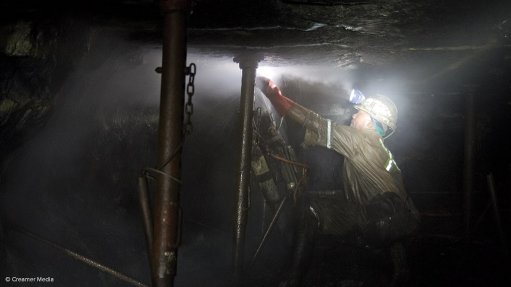
JOHANNESBURG (miningweekly.com) – Labour unrest has hurt South Africa’s mining output, Nedbank’s Economic Unit said as Statistics South Africa (Stats SA) noted a slowing in mining production during January.
The ‘Mining production and sales’ report for January, released on Thursday, showed year-on-year growth slowing to 3.1% from the 12.2% increase reported in December.
An 8.4% month-on-month rise in coal production in January helped soften the blow to overall mining production, despite a year-on-year slip of 7.9%.
Iron-ore, with an 11.7% year-on-year increase, and manganese ore, with a 25.5% year-on-year jump, emerged as the main contributors to the 3.1% rise in total mining output.
On a monthly basis, seasonally adjusted mining production declined 1.1%, compared with the 6.9% monthly expansion reported in January 2013, on the back of a 3.7% fall in platinum group metals (PGMs) production.
“The labour unrest in the platinum mining sector has already hurt mining production,” the Nedbank Economic Unit said.
Both gold and iron-ore production also contributed to the month-on-month decline, slipping 3.3% and 8.5% respectively.
“Mining output has been volatile, mainly [owing] to labour unrest in the sector. Continued labour unrest in some parts of the sector, infrastructure constraints and lower growth in China will probably continue to have a negative impact on production,” Nedbank added.
Investec economist Kamilla Kaplan said it was likely that quarterly growth, which registered at 4%, would slow further owing to the strike-induced work stoppages, which started on January 23.
“PGMs production comprises nearly a quarter of total mining production and the impact to date has been significant,” she noted.
The strike action across Anglo American, Impala Platinum and Lonmin, which collectively accounted for 80% of global PGMs production, had resulted in combined and cumulative production losses of 499 000 oz of platinum.
“This loss has already surpassed the 496 359 oz loss during the 2012 strike action,” Kaplan explained.
“Given the longevity of these strikes, we believe that platinum stockpiles must also be wearing thin, which, therefore, also places the export sector at risk should a wage agreement not be struck soon, [as] PGM’s are South Africa’s single largest export commodity,” said BNP Paribas Cadiz Securities economist Jeffrey Schultz.
“While headline growth in mining production has managed to remain in the black for seven consecutive months now, we remain cautious on the near- to medium-term outlook for this side of the economy,” he said.
Schultz added that State-owned power utility Eskom’s curtailment of up to 20% of energy use by large industrial users and mines could impact mining activity in the first half of the year.
“This, coupled with rising input costs and [the] uncertain outlook for global commodity prices, leaves us expecting little meaningful contribution from the mining sector to overall gross domestic product (GDP) growth in the near to medium term,” he said.
Kaplan noted that the “weaker start” to the first quarter of 2014 suggested that the contribution of the mining sector to GDP growth would be smaller than that of the fourth quarter of 2013.